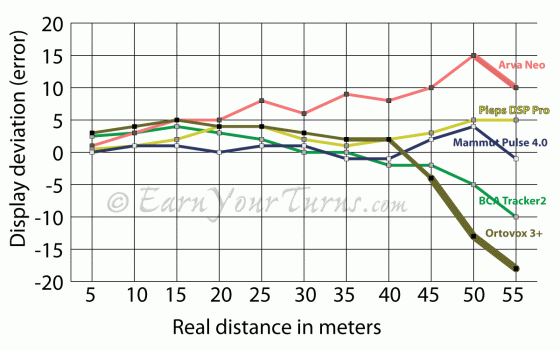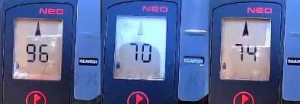The bounce is magnified the further away you are, and is slowly reduced until, when it really matters the most, when you’re close and need to know where to probe it becomes pretty darn accurate. However, the further away you are, the more pronounced the variation in successive numbers displayed tends to be.
By bounce I mean the variation in the distance reading. If it were an analog display what we might see instead is a volume bar or needle that jiggles up and down about an average position, which theoretically might be the real position.
Bounce aka Distance Error
In the process of reviewing avalanche beacons for an update on relative performance I was struck by the fact that every digital beacon exhibits this sort of bouncy digital response, but some clearly had less bounce than others, and those with less variation in the distance readings tended to be more accurate.
This is a phenomenon that everyone I know who have ever used an avy beacon has noticed, and has also tended to automatically account for and more or less ignore. You notice it especially when you first pick up a signal. The actual distance changes from pulse to pulse — 65, 70, 66, 58, 65, blank, 60, blank, 68. Your actual position might be 55 meters away, but those are the readings you get. As you get closer, you should notice less variation, but if the trend is for decreasing distance you assume you’re on the right track and, hopefully, the direction arrows aren’t bouncing back and forth too, but tend to be straight ahead, with an occasional indication to veer left or right. Again, we tend to ignore these instantaneous snapshots of signal distance and direction because, afterall, we’re conditioned to digital noise. In a real scenario, once you pick up a signal the general direction to head should be roughly the same as the avalanche path and that will only shift to one side or the other as you get closer.
…the phenomenon of bounce, or jitter, or noise in the distance readings of modern avalanche beacons is something easily accounted for with your brain.
…practice using your beacon so you are familiar with the degree of bounce your beacon may have.
The question that arose in noticing this common phenomenon was how to characterize it. Despite having a sense that some beacons were worse in this regard than others, I needed some hard evidence to back up my gut and give it boundaries.
Modern electronics to the rescue. I recorded the display response of several beacons to a single victim scenario, with parallel, best-coupled orientation. Then I wrote down each successive display update as recorded and compared them to the actual distance I was at. The results are interesting, but not something I would base my decision on which beacon to buy – not entirely.

Out of five models, Tracker2, the Pulse 4.0, and new DSP Pro are the most accurate long range. They all over-estimate distance under 10 meters, but at that point sensitivity to curvature of the field lines is more pronounced and we might expect the display to indicate a target distance greater than the straight line distance. click to enlarge
Overall I think the phenomenon of bounce, or jitter, or noise in the distance readings of modern avalanche beacons is something easily accounted for with your brain. This does imply a duty to practice using your beacon so you are familiar with the degree of bounce your beacon may have. It is worth noting that the greater the error, or deviation from the actual distance, the greater the variance within that error. In other words, if you see a deviation of 10 meters, that means the average deviation was about 10, but it may have varied by as much as 5 either way whereas a deviation of only 2 or 3 usually only differed by 1 or 2 above or below that as well. Furthermore, as the graph shows, the further way you are the greater the expected error. This makes sense since this is where the signal is weakest and thus more prone to sampling error for all beacons although Pieps tends to not indicate anything unless the victim’s signal is within range.
It is worth pointing out that even though the absolute error between the display distance and actual distance is minimized as you get closer it is important to slow down the closer you get. In the event that there is only one victim, slowing down merely improves accuracy. Not slowing down, and moving the receiving beacon quickly is likely to give erroneous readings since the display may indicate the distance and direction for where you were one second ago (plus averaging), not where the beacon is when it updates the display. It is even more essential to slow down in the case where there is more than one victim, especially if the receiving beacon is indicating they are less than 10 meters apart. So remember to slow down as you get closer, even though your natural inclination is to speed up. Being more accurate on where to dig will improve the odds of a live rescue as opposed to a body recovery exercise.
And remember, don’t use the masking feature with modern digital beacons until you have physically confirmed the location of a victim with a probe. Then you can mark it as found, and focus on excavation or searching for the next signal.
If you’re in the market for a new beacon and all other features balance out, then yes, picking one with less bounce and more distance accuracy would be the better choice.
© 2014


7 pings
Skip to comment form
[…] « Technique: Dealing with bouncing avy beacons […]
[…] Pieps DSP review Bouncing Avalanche Beacons EYT Test Range for Avalanche […]
[…] Posts Review: Arva Neo v1 Bouncing Avy Beacons Home on the Range: How this test was performed BackcountryTalk: Beacon BBQ […]